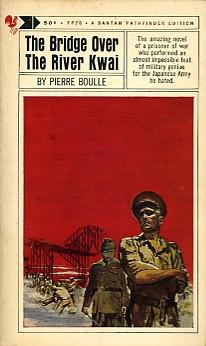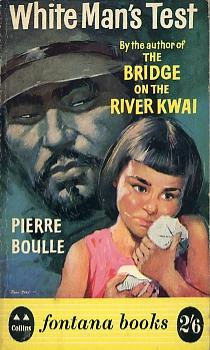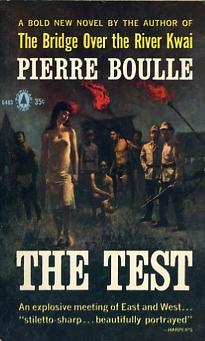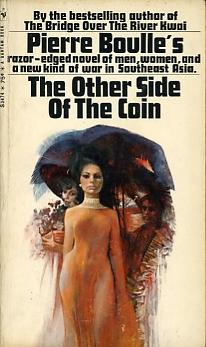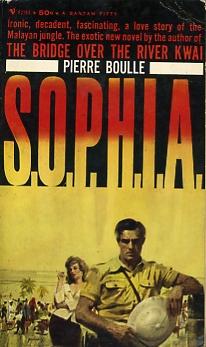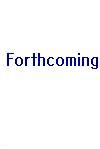The Bridge on the River Kwai
From Indochina to the Monkey Planet
By William Wetherall
First posted 15 September 2006
Last updated 15 September 2006
Peter Boulle, The Bridge on / over the River Kwai, 1952 (French), 1954 (English)
Peter Boulle, White Man's Test / The Test, 1955 (French), 1957 (English)
Peter Boulle, The Other Side of the Coin, 1958 (French), 1958 (English)
Peter Boulle, S.O.P.H.I.A. 1959 (English)
Peter Boulle, Planet of the Apes / Monkey Planet 1963 (French), 1963 (US), 1964 (UK)
Peter Boulle (1912-1994)
Pierre Boulle was born in France, where he was educated and worked as an electrical engineer before going to Malaya in 1938. He was overseeing a rubber planatation near Kuala Lumpur when World War II began in Europe.
Boulle was in the French army in Indochina, and when Germany occupied France he joined the Free French Mission in Singapore and helped the reistance in Indochina, Burma, and China as a secret agent named Peter John Rule.
Boulle was captured, not by Japanese, but by Vichy French loyalists on the Mekong River in 1943. The next year he escaped from a prison in Saigon and spent the rest of the war in the British special forces.
After the war Boulle returned to the plantation in Malaya for a while then returned to France, where he began writing, mostly fiction, much of it set in his favorite Southeast Asian haunts. His first novel, William Conrad (1950), based on notes he made in prison, was published in English as Not the Glory (1955, US) and Spy Converted (1960, UK).
Le pont de la riviere Kwai (1952), translated into English as The Bridge on over the River Kwai (1954), made him famous. La Planete Des Singes (1963), or Monkey Planet / Planet of the Apes(1963) in English, made him even more famous.
The Bridge on / over the River KwaiPierre Boulle Pierre Boulle 186 pages, paperback (S3474) Work on the Siam-Burma Railway began in the fall of 1942. It was completed in sixteen months, around the spring of 1943. The construction of "Death Railway" is fictionalized in Pierre Boulle's novel Le pont de la riviere Kwai (Paris: Rene Julliard, 1952). The English translation by Xan Fielding was published in 1954 in the UK as The Bridge on the River Kwai in the UK (London: Secker & Warburg) and in the US as The Bridge over the River Kwai (New York: Vanguard Press. The 1957 Columbia Pictures adaptation of the translation was titled after the UK edition. "The Bridge on the River Kwai", filmed mostly in Ceylon and taking more liberties with the truth than the novel, won several Academy Awards. Boulle (1912-1994), who was not fluent in English, had been credited for the screenplay, hence he received the Academy Award for Best Adapted Screenplay. The script was actually written by Carl Foreman and Michael Wilson, who had been blacklisted by the Motion Picture Academy at the time. Their names were not added to the award until 1984. Talk about war crimes and delayed justice. To be continued. |
White Man's TestPeter Boulle Peter Boulle The English translation of this story, which is set in wartime Sumatra and Singapore, was published in the United Kingdom and the United States with different titles in 1957, later in paperback editions. The novel seems to have attracted the least attention of any of the English translations of Boulle's wartime or postwar fiction set in Southeast Asia, despite the obvious attempt by publishers on both sides of the Atlantic to capitalize on the popularity of the Bridge on the River Kwai and its film version. According to the Popular Library blurb, "Set against the blazing background of WWII, this is the story of an interracial relationship between a young white girl and a dark skinned young man, a native ritual that would test the girls womanhood, and a terrible ordeal devised by her own people, more terrible and far crueler than the first." To be continued. |
The Other Side of the CoinPierre Boulle The Other Side of the Coin is a political thriller involving entangled loyalties. Chinese terrorists attack a rubber planatation in the Malayan jungle north of Singapore. The novel appeared right after the release of "The Bridge on the River Kwai", and Otto Preminger planned to adapt it into a film, but the project was never realized. To be continued. |
S.O.P.H.I.A.Pierre Boulle S.O.P.H.I.A. is a love adventure set in postwar Malaya. Beneath the live bait on the fly page is a barbed hook.
To be continued. |
Planet of the ApesPierre Boulle Pierre Boulle London: Secker & Warburg, 1964 223 pages, hardcover Boulle transports readers to jungles on another planet in another solar system, rather than to jungles on Earth, for high adventure and romance between humans and apelike humans or humanlike apes, as you wish -- I've been called both. To be continued. |
